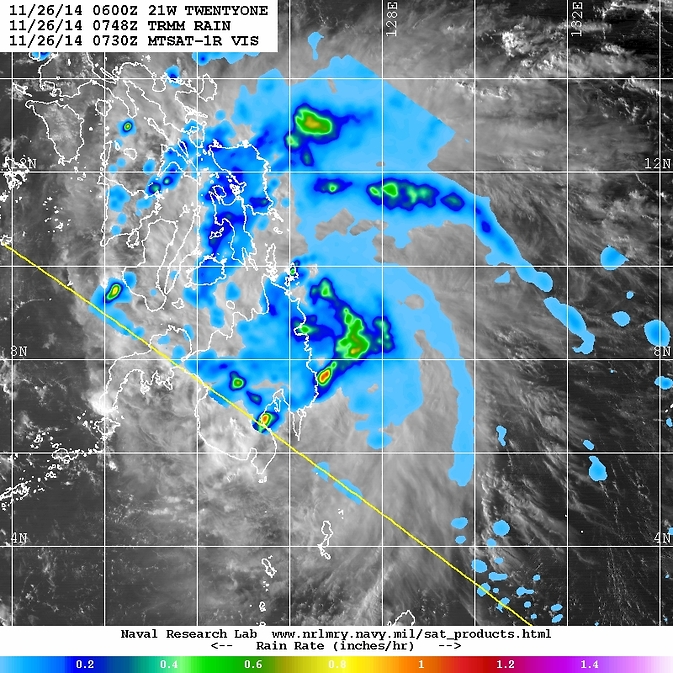Tropical Depression 21W Forms, Philippines Under Warnings

On Nov. 26, the TRMM satellite revealed areas of heavy rainfall in fragmented bands east of the center of circulation, where rain was falling at more than 1 inch (25 mm) per hour (red). Japan's MTSAT-1 satellite provided cloud data. Image Credit: NASA/NRL
TRMM revealed areas of heavy rainfall in fragmented bands east of the center of circulation, where rain was falling at more than 1 inch (25 mm) per hour.
TRMM rainfall data was overlaid on infrared data from the Japan Meteorological Agency's MTSAT-1 satellite that showed Tropical Depression 21W's (TD21W) clouds extended from western Mindanao, east into the Philippine Sea.
On Nov. 26, there were a number of warnings in effect for the Philippines. Public storm warning signal #1 was in effect for the province of Luzon that includes: Palawan and the Calamian Group of Islands. In Visayas: Southern Leyte, Bohol, Southern Cebu Including Cebu City, Negros Oriental, Southern Negros Occidental and Siquijor. In the province of Mindanao:
Surigao del Norte including Siargao Island, Surigao del Sur, Agusan del Norte & Sur, Dinagat Province, Camiguin, Misamis Oriental & Occidental, Bukidnon and Zamboanga del Norte.
At 1500 UTC (10 a.m. EST), TD21W was centered near 8.7 north longitude and 125.4 east latitude. That's about 468 nautical miles (538.6 miles/866.7 kph) southeast of Manila, Philippines. Maximum sustained winds were near 30 knots (34.5 mph/55.5 kph). TD21W is moving to the west at 9 knots (10.3 mph/16.6 kph).
TD 21W is forecast to continue tracking westward along the southern edge of a sub-tropical ridge of high pressure which is located to the north of the depression and oriented east-west. The Joint Typhoon Warning Center forecasts TD21W to move over northern Mindanao late on Nov. 26 and weaken. By Nov. 27, TD21W is expected to emerge into the Sulu Sea where it is expected to strengthen.
Rob Gutro
NASA's Goddard Space Flight Center
Media Contact
All latest news from the category: Earth Sciences
Earth Sciences (also referred to as Geosciences), which deals with basic issues surrounding our planet, plays a vital role in the area of energy and raw materials supply.
Earth Sciences comprises subjects such as geology, geography, geological informatics, paleontology, mineralogy, petrography, crystallography, geophysics, geodesy, glaciology, cartography, photogrammetry, meteorology and seismology, early-warning systems, earthquake research and polar research.
Newest articles

Innovative vortex beam technology
…unleashes ultra-secure, high-capacity data transmission. Scientists have developed a breakthrough optical technology that could dramatically enhance the capacity and security of data transmission (Fig. 1). By utilizing a new type…

Tiny dancers: Scientists synchronise bacterial motion
Researchers at TU Delft have discovered that E. coli bacteria can synchronise their movements, creating order in seemingly random biological systems. By trapping individual bacteria in micro-engineered circular cavities and…

Primary investigation on ram-rotor detonation engine
Detonation is a supersonic combustion wave, characterized by a shock wave driven by the energy release from closely coupled chemical reactions. It is a typical form of pressure gain combustion,…



